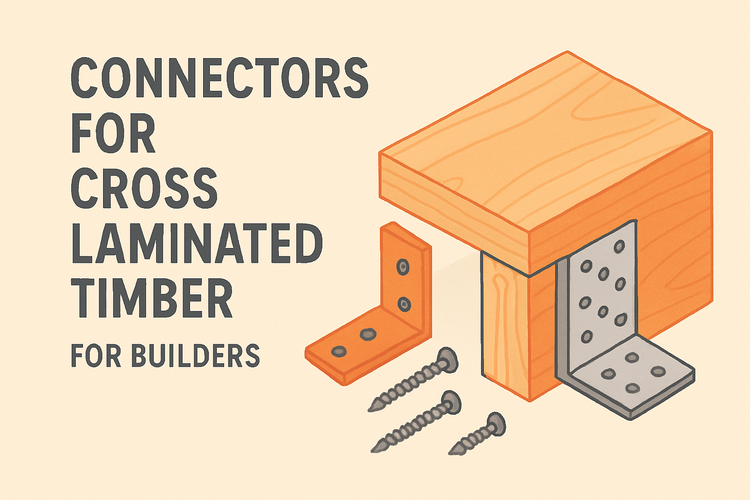Complete Guide To Connectors For Cross Laminated Timber For Builders

Understanding the Role of Connectors in CLT Construction
Connectors for cross laminated timber are foundational components that ensure structural integrity in modern timber builds. They provide reliable jointing solutions essential for every stage, from initial stability to long-term durability.
In cross laminated timber (CLT) construction, connectors are the linchpin of performance and safety. These fastening systems allow the prefabricated timber panels to securely integrate with supporting elements such as steel, concrete, or other timber. The selection of the right [connectors for cross laminated timber](https://jandeconstruction.co.uk/collections/connectors-for-cross-laminated) determines not only the speed of construction but also the capacity of the structure to resist dynamic loads such as wind and seismic movement, making them critical in high-performance buildings.
The compatibility of connectors with CLT panels is influenced by the layer orientation and thickness of the timber. Engineers must consider moisture content, deflection, and service conditions when specifying brackets, screws, and ties. Additionally, the fire resistance and acoustic separation properties of CLT construction are directly impacted by the quantity and configuration of connectors, further emphasizing the importance of proper design and installation.
Types of Connectors Suitable For Cross Laminated Timber
CLT construction benefits from a wide variety of specialized connectors. From hidden fasteners to exposed metal brackets, the choice directly affects the aesthetics and performance of the timber frame.
Angle brackets and joist hangers are among the most commonly used connectors for structural junctions in CLT systems. These elements ensure precise load transfer between vertical and horizontal components, contributing to the seamless integration of walls, floors, and roofs. Products like [angle brackets](https://jandeconstruction.co.uk/collections/angle-bracket) can be surface-mounted or recessed for architectural finesse, depending on project requirements.
Joist hangers are particularly critical when dealing with the repetitive span elements embedded within floor panels. With a focus on ease of installation and load distribution, these [joist hangers](https://jandeconstruction.co.uk/collections/joist-hangers) support large-format CLT panels without introducing point stress. Similarly, other connectors such as splines, screws, and shear plates are purpose-engineered to maximize shear resistance and rigidity in multi-layered timber construction.
Structural screws and dowels also play a vital role, especially in transferring in-plane and out-of-plane forces in panel connections. Precision in screw type, angle of insertion, and embedment depth ensures that the connection adheres to the stringent performance criteria set out in European and UK timber standards. Hidden mechanical connectors offer a sleek aesthetic while meeting stringent load bearing requirements.
Installation Guidelines and Best Practices
A proper installation process ensures connector efficiency and longevity in CLT structures. Adherence to manufacturer guidelines and on-site coordination are key factors in achieving this.
Builders must closely follow layout drawings and technical specifications to position and secure connectors appropriately. Ensuring alignment before mechanical fastening not only enhances structural performance but also minimizes on-site adjustments. Use of temporary bracing during installation helps maintain joint positions as permanent fixings are applied.
Tools like torque-controlled drills, guide jigs, and laser alignment systems are commonly employed to ensure precision and uniformity in screw placement. Fitment tolerances in connectors such as restraint straps or load transfer brackets can alter performance if inadequately fitted. Therefore, each connector, from post bases to high wind ties, must be installed to manufacturer specifications including angle, depth, and orientation.
Post-installation inspection should also be conducted, verifying fastener tightness and checking for signs of timber splitting or over-compression. In areas with high lateral or uplift loads, reinforcement using additional [high wind ties & timber connectors](https://jandeconstruction.co.uk/collections/high-wind-ties-timber-connectors) may be warranted. Documenting every connection detail also aids in future maintenance and structural audits.
Connector Performance in High Stress Environments
Cross laminated timber structures are increasingly used in tall buildings and seismic zones, demanding connectors that can withstand significant mechanical and environmental stresses.
The behavior of connectors under high wind, seismic, and dynamic loading is a major consideration in design. Uplift resistance, ductility, and resistance to fatigue are tested in modern connector systems to ensure they comply with wind code and earthquake standards. For instance, roof assemblies often require resilient [roof connectors](https://jandeconstruction.co.uk/collections/roof-connectors) that accommodate movement without failure.
Connections at roof-to-wall or floor-to-wall interfaces are vulnerable points in the building envelope. Specialties such as structural straps, tension ties, and embedded steel plates are used to manage multi-directional loads without compromising flexibility. Integrating seismic connectors ensures continuity and mechanical redundancy in case of shock loading, which is especially important for critical facilities like hospitals or schools built with CLT.
Connectors like post bases and fixed restraint anchors contribute significantly to load transfer from the timber element into foundations and concrete interfaces. The use of adjustable [post bases](https://jandeconstruction.co.uk/collections/post-base) offers flexibility in the field, while still satisfying design tolerances for axial and shear forces. With increasing regulatory requirements, engineers increasingly value field-tested connectors that maintain their strength over time without degradation from moisture, corrosion, or fatigue.
Integration of Connectors in Timber Frame Systems
While CLT often integrates with hybrid systems, there’s growing importance in synergy between CLT panels and traditional timber frame methodologies.
Connectors facilitate seamless integration between engineered wood products such as CLT and glulam beams. Timber frame buildings benefit from optimised connector layouts that distribute loads across intersecting elements without introducing material incompatibility. Using [timber frame connectors](https://jandeconstruction.co.uk/collections/timber-frame-connectors) that are compatible with CLT geometry enables cohesive hybrid construction that maintains performance through the entire superstructure.
This integration extends to bracing scenarios as well, where restraint straps are used internally between posts and walls to enhance stiffness. For long-span or cantilever conditions, brackets and tension systems must accommodate potential timber creep, thermal movement, and settlement over time. Combining CLT with glulam requires additional connectors like multi-axis bolts or U-shaped saddles tailored for composite action.
The long-term success of any load-bearing timber construction lies in its joints. Products designed specifically as [connectors for glulam timber](https://jandeconstruction.co.uk/collections/connectors-for-glulam-timber) offer strength without compromising the natural expansion and contraction of wood. These tailored solutions ensure your CLT and glulam composites work in unison, even under complex loading scenarios.
